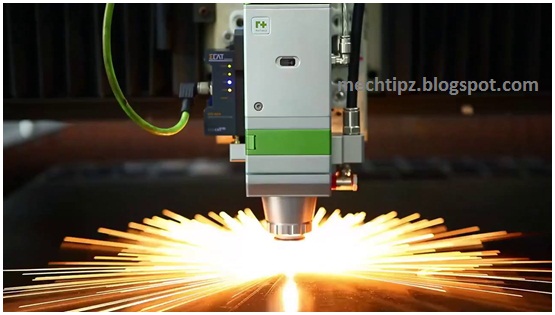What is CNC Laser Cutting?
CNC Laser cutting is a modern technology that works with a laser to cut materials, and is commonly used for industrial manufacturing applications, but is also starting to be used by programs, small businesses, and hobbyists. It works by routing the output of a high-power laser most commonly through optics. The laser optics and CNC (computer numerical control) are used to point the material or the laser beam generated.
A typical industrial laser for cutting materials consisted of a motion management system to follow a CNC or G-code of the pattern to be cut onto the material. The targeted laser beam is guided at the material, which then either melts, burns vaporize away, or is blown away by a jet of gas, keeping an edge with a high-quality surface appearance. Industrial laser cutters are used to cut flat-sheet material as well as structural and piping materials.
CNC Laser Cutting Brief History
In 1965, the original production laser cutting equipment was used to drill holes in diamond dies. This machine was made by the Western Electric Engineering Research Center. In 1967, the British pioneered laser-assisted oxygen jet cutting for metals
In the early 1970s, this technological innovation was put into development to cut titanium for aerospace applications. At the same time CO2 lasers were modified to cut non-metals, such as fibers, because, at the time, CO2 lasers were not strong enough to overcome the thermal conductivity of metals.
Types of Laser Cutting Machines
- Rotary Laser Cutting: Rotary laser cutting is mainly used for laser cutting of steel tubes and pipes. Sawing, drilling or milling were the major Conventional means used to process tubes or pipes but rotary laser cutting is more updated & provide substantially reduced production cost benefits. Rotary laser cutting helps to process round tube, ellipse tube, rectangular tube, D-type tube materials. Laser Cutting System Manufacturers extend Rotary laser cutting machines to process with high speed, accuracy and precision
- Robotic Laser Cutting: Robotic Laser Cutting is the latest 3D laser cutting innovation which extends outstanding flexibility and great power control. The process can be monitored & accessed from anywhere. The cutting is done with high precision with specialized laser cutting head which has advanced autofocus sensors. Laser Cutting System Manufacturers provide Robotic Laser cutting machines which give efficient & effective output with the multi-axis mechanical arm.
- Small Format Laser Cutting: It is mainly required for metals & nonmetals & has Adjustable Z-axis to cut thick materials with high accuracy. The height can be adjusted to maintain the focus length and produce high-quality material. They require almost no maintenance as compared to the conventional means of laser cutting and produce perfectly finished outputs
- 5 Axis Laser Cutting: Laser Cutting System Manufacturers provide 5 Axis Laser Cutting machines which have the ability to do three-dimensional profile cutting and also cutting of two-dimensional metal sheets. Axis laser cutting yields in highly cost-effective outputs as compared to the conventional means. Laser Cutting Systems India has rolled out 5 Axis laser cutting machine which is extremely versatile & provides time-saving solutions and helps to reach to areas which other would be very difficult to reach
- Large Format Laser Cutting: Laser Cutting Systems India provides Large Format Laser Cutting machines which offer 2D large format profile laser cutter.They are mainly used for high level of efficiency required for Aerospace, Automotive, Sheet Metal Fabrication, Ship Building, Signage and many more materials. They provide highly accurate & cost effective results
CNC Laser Cutting Process
Advantages of CNC laser cutting over mechanical cutting, including being more accurate, utilizing less energy when cutting sheet metal, much easier work holding and reducing contamination of workpiece (since there is no cutting edge which may become contaminated by the material or taint the material). Accuracy may be better since the laser beam does not wear during the procedure. There is also a reduced possibility of warping the material that is being cut, as laser systems have a tiny heat-affected zone. Some materials are also very difficult or tough to cut by more ordinary means.
However, most industrial lasers can not cut through the greater metal thickness that plasma can. More recent laser machines functioning at higher power (6000 watts, as contrasted with early laser cutting machines’ 1500 watt ratings) are moving toward plasma machines in their capacity to cut through thick materials, but the capital cost of such units is much higher than.
The parallel rays of coherent light from the laser source often fall in the range between 0.06– 0.08 inches (1.5– 2.0 mm) in diameter. This beam is typically focused and magnified by a lens or a mirror to a very tiny spot of about 0.001 inches (0.025 mm) to create an extremely intense laser beam. To reach the smoothest attainable appearance during contour cutting, the path of beam polarization must be revolved as it goes around the periphery of a contoured workpiece. For sheet metal cutting, the focal length is usually 1.5– 3 inches (38– 76 mm).
Mirrors or fiber optics are usually used to direct the coherent light to a lens, which concentrates the light at the work zone. The narrowest part of the centered beam is less than 0.0125 inches (0.32 mm). in diameter. Depending upon material thickness, kerf widths as small as 0.004 inches (0.10 mm) are possible.
In order to be able to start cutting from somewhere other than the edge, a pierce is done before every cut. Piercing normally involves a high-power pulsed laser beam which slowly makes a hole in the material, requiring around 5– 15 seconds for 0.5-inch-thick (13 mm) stainless steel, for example.
Generation of the laser beam entails stimulating a lasing material by electrical discharges or lamps within a closed container. As the lasing material is stimulated, the beam is reflected internally using a partial mirror, up until it obtains appropriate energy to escape as a surge of monochromatic coherent light.









